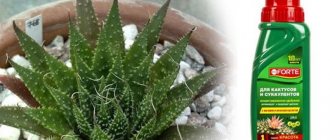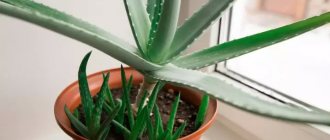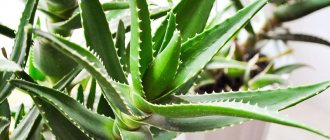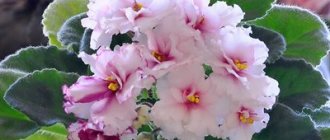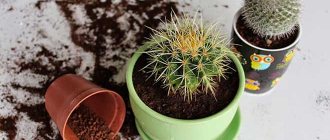Aloe is a common indoor succulent. It is valued for its unusual appearance and healing qualities. It is native to South Africa, where moisture is common during the rainy season. Over the course of its evolution, aloe has adapted so well that it can survive without watering for a long time. However, the plant still needs proper watering: this is the key to its health. We will tell you exactly how to water aloe at home in this article.
When to water a houseplant 2. How to water aloe 3. Two options for moisturizing a houseplant 4. Features of the procedure after replanting 5. How to properly moisturize aloe 6. Errors in care
Photo by ru.depositphotos: It’s better to underwater than overwater an indoor succulent.
Watering aloe - how to do it correctly so as not to destroy the plant
Aloe does not need frequent watering, since its leaves are able to accumulate and retain moisture. Excess water, as well as its lack, directly affect the health of the succulent. To avoid flower diseases, it is important to know how often you need to water aloe.
Aloe in a pot
The frequency of water procedures depends on several factors:
- season;
- air temperature and humidity;
- age of the succulent;
- degree of illumination of the house.
To determine whether an aloe needs watering, you need to dip your finger or toothpick into the pot to a depth of about four centimeters. If this layer of soil is dry, the plant needs water. The soil located higher evaporates moisture faster and is not an indicator of the moisture content of the plant’s root system.
Outdoor plants do not need additional watering on rainy days. In dry weather, moderate moisture will be needed, which is best done after sun exposure.
Pot and soil for aloe
The photo shows aloe in a plastic pot with a tray
If your aloe looks sickly and doesn't want to grow, think about the quality and size of the pot.
Firstly, the pot must be of sufficient volume, not large and not too narrow. The ideal pot size is half the length of the plant's leaves. Until the root system has grown sufficiently, new shoots will not appear.
Secondly, the pot should have drainage holes and a deep tray so that it is convenient to water from both above and below, and the water does not stagnate in the ground after that.
Pot with drainage holes
Thirdly, keep in mind that if you choose a clay product, then watering should be more abundant, since moisture will be absorbed by the ceramics and evaporate from the walls. Plastic or glass products can be used, but good drainage is desirable.
To transplant plants, use pots that are at least 2-3 centimeters larger than the previous ones (both in diameter and height).
On a note! If your plant has aerial roots, use a flat pot.
How to choose a pot for a plant
The quality of the soil in which the succulent is planted is also important. Heavy clay soils are not suitable; it is better to use a ready-made substrate for cacti or mix rotted leaf soil with fine river sand in a 2:1 ratio. You can also use a mixture that is more complex in terms of the number of components, combining sand, humus, leaf and turf soils in a ratio of 1:1:1:2. Expanded clay, pumice or coarse washed river sand can be used as drainage.
Soil for planting aloe
Cactus soil is suitable for planting aloe
In which organs does a flower store moisture?
How to plant aloe correctly at home
This succulent is known for its ability to live without water for a long time. It will survive even if you dig it out of the ground and leave it in the air for several months.
The plant has long, fleshy leaves with small spines on the sides. Each leaf consists of pulp, which stores moisture, and a thick shell. It can retain water by closing its pores.
The cross-sectional photo of the leaf clearly shows the skin, which keeps the soft inner part of the leaf moist
When is the best time to do this?
The best period for rooting aloe in a new container will be spring; it is important to choose the right time so that the plant is just emerging from the dormant phase and has not yet begun to actively develop. If you have time to replant a succulent during this period, the active metabolism that accompanies the growing season will help the crop quickly adapt to new conditions and maintain its health.
This is especially true for the root system, which in any case will be disturbed and injured during the process of removing the plant from the old soil and rooting in a new container. Some gardeners transplant aloe in the summer, while simultaneously propagating the crop.
It would be better to refrain from such work in the autumn and winter, since at this time the succulent will already suffer from a lack of sunlight, which will weaken its immunity. In addition, the autumn-winter period is the resting phase for aloe. As a result, the flower will need much more time to adapt to new conditions.
How to water a plant
How to water Zamioculcas correctly so as not to destroy it
Depending on the age of the aloe, two watering methods are used:
- Young plants are moistened with preheated liquid through the bottom of the pot. To do this, you can put the aloe in a deep container with water or pour water directly into the tray. This method of watering is considered to be the most gentle, since when it is used, beneficial substances are not washed out of the soil.
- The soil with mature plants is watered generously from a watering can, avoiding getting it on the leaves - the accumulation of liquid in aloe rosettes can lead to rotting of the stem. To ensure that the soil absorbs all the moisture, it is first loosened. Do not direct the stream of water at the roots - this can expose them.
Important! Aloe should never be sprayed. This will not bring any benefit, but will only harm the flower - the leaves may get burned or begin to rot.
If dust accumulates, wipe the leaves with a damp cloth or cotton pad.
An hour after watering, you need to drain the remaining water from the pan.
Depending on the time of year
Each time of year has its own characteristics of watering agave.
After winter, the plant needs more moisture, which it needs to grow. In spring, it is watered once a week, and in summer the interval is reduced to twice a week.
In late autumn and winter, the bush requires almost no watering, as it is at rest.
How to water seeds
Propagation by seeds is a complex and not the most popular method of propagating aloe.
The germination process occurs as follows:
- The seeds are soaked in a weak solution of potassium permanganate and placed in a container with previously loosened soil, lightly pressing them into the surface. The distance between them should be about two centimeters.
- A small layer of sand is poured onto the ground.
- The container is lowered into a tray with warm water for some time.
- After moistening the soil, the container is transferred to a warm room. The soil must remain moist before the seeds sprout.
After the first shoots appear, the plant will need to be watered lightly once a week.
Watering shoots during propagation
The easiest way to propagate agave is by cuttings. After cutting aloe cuttings, they should not be placed in water. The shoots are sprinkled with wood ash and kept in air until roots appear.
Another option is to place them in a container of damp sand. This usually lasts several weeks. Afterwards they are placed in a pot with dry soil. At first, young shoots are not watered.
Transplanted aloe sprout
Important! The pot should have several holes at the bottom for water to drain after watering. A shallow tray is placed under the pot.
Choose a pot that is wide enough, otherwise the roots won't grow. The diameter of the pot should be approximately one half the length of the aloe leaf.
Watering during transplantation
Before transplanting aloe, it should not be watered for a month. The plant must be replanted into already moist soil. Watering for the first week after this is also not recommended.
The frequency of replanting a succulent depends on the age of the plant. Young aloe plants are planted once every two years, adults - every four years. It is recommended to do this in the spring. It is during this period that the agave is most ready for growth.
In nature, aloe grows in sand, but at home it is planted in soil consisting of sand, leaf soil and turf. The soil should be loose and soft. A layer of drainage is laid out at the bottom of the pot. For this, you can use any suitable material, for example, broken brick.
Popular techniques
- Top watering is the most well-known and understandable method. Using a watering can, moisture is supplied directly to the roots, avoiding contact with the foliage.
- Bottom watering - food comes through a drainage hole from a deep pan filled with water. After an hour, the remaining liquid is drained, preventing the development of fungus.
- The full immersion method is an effective method that is used in special cases when it is necessary to urgently saturate the plant with moisture.
Water preparation is of great importance, since tap liquid drawn from the tap is too hard. To soften it, flower growers first leave the water for 24 hours in an open container, and then freeze it or acidify it with citric, oxalic or other acid. It is important to water with water at an optimally comfortable temperature for the plant (+18…25 °C).
Quality of water for irrigation, which one is better to use
Aloe should only be watered with soft water, the temperature of which should be several degrees higher than room temperature. In summer, the water is additionally heated. Too hard water forms a coating on the soil, and cold water can lead to rotting of the roots.
Is it possible to spray geraniums with water and how to water them correctly
There are several ways to prepare water for irrigation:
- Pour filtered or boiled water into a container and leave for a day.
- Freeze for several hours. Then let it sit for at least a day.
- Add a little citric or acetic acid (5 g per liter) to purified water.
- Use melted snow.
Important! Do not use tap water. It may contain substances harmful to the plant, such as chlorine and alkalis.
The process of watering agave
Reproduction methods
Aloe can be propagated in different ways - vegetatively or by seeds. Vegetative propagation by lateral shoots, children, and leaves is more often used.
- Side shoots. In spring or summer, side shoots are separated from the base with a sharp knife. The sections are sprinkled with activated carbon and dried for two days in a dark, well-ventilated place. The shoots are slightly buried at the base in wet sand. Roots appear quickly - within a week. Rooted shoots are planted in separate pots and cared for like adult plants.
- Leaf. Leaves are rooted similarly to side shoots. The leaf is cut off at the very base, treated with charcoal powder, and dried. Planted in wet sand. Do not cover with film! After the shoots appear, they are transplanted into a pot.
- Children. Young shoots with an already developed root system appear next to the mother bush. When transplanting aloe, it is carefully separated and planted in separate pots.
- Apical cuttings. Cut off the top with five to seven leaves. After treatment with charcoal and drying, it is rooted in wet sand or in a glass of water. This method is used if the root system is damaged and you need to plant aloe without roots. Sometimes this is the only way to save a plant from root rot.
- Seeds. Growing from seeds is a long and labor-intensive process. Sow the seeds in a light sand-peat mixture, spray with a spray bottle, and cover with film until germination. Maintain the temperature at least 20°C. Slightly grown seedlings need to be planted. After a year, they are transferred to full-fledged pots.
The main problem with aloe is root rot. Therefore, drainage is required. Reviews from experienced flower growers contain recommendations for using crushed birch charcoal as a drainage material.
The combination of watering and applying liquid fertilizer during cultivation
Fertilizing for home succulents can be done along with watering: it is better to use fertilizers during or after watering. Such procedures are carried out only during the period of active growth of aloe - from March to September, and no more than three to four times per season.
Rich soil is fertilized only once. Excess feeding can cause root burns. Humic fertilizers, potassium phosphate and special ready-made mixtures marked “for succulents” are used as fertilizers.
In some cases, aloe cannot be fed:
- young plants up to three years old;
- sick or infected with parasites;
- victims of sun rays or lack of moisture;
- plants that will be used for cosmetic or medicinal purposes.
Interesting! Diluted aloe juice can be used as a natural supplement. Another popular “folk” recipe is sweet sugar water. To prepare it, dissolve one tablespoon of sugar in a glass of water.
Signs of an incorrect procedure
The plant suddenly began to change color, the leaves darken and become yellow or brown, becoming smaller - this picture should alert the gardener. It’s easy to understand that the watering mode is chosen incorrectly:
- If watered too much, the leaves become yellow, watery, and fall off easily.
- Small leaves with enlarged serrations, thinning old leaves - watering is too poor.
- An unpleasant odor appears from the soil, islands of mold on it - waterlogging, which threatens the death of the plant, or improper watering from above.
- Blackened tips of foliage - probably roots rotting from excess moisture require replanting.
- The stems breaking, the trunk falling to the side, its breakage near the base - they were probably watered abundantly, often, from above, which caused rotting of the root collar and weakening of the cuttings.
By carefully observing your green friend, you can always understand what caused his changes
It is important to normalize the situation in time so as not to destroy the plant, choose the correct temperature and watering order. Then aloe will please the eye, it can always be used as an ambulance for various diseases and for cosmetic procedures
What happens if you do not comply with the conditions for keeping aloe
Caring for homemade aloe consists of properly maintaining the level of heat, moisture and light. Under natural conditions, this succulent grows in hot and arid climates, so it is demanding on the level of air humidity. If the plant is very dry, the stems may become wrinkled; it is recommended to wipe them with a damp cloth.
The aloe pot should be in a warm, well-lit place. Window sills on the south side are best suited. In summer, agave prefers a temperature of about 25 degrees Celsius. On days when there is no rain, aloe can be taken out into the open air. In winter, the room temperature is reduced by 5-10 degrees.
If the above conditions are not observed, the houseplant will begin to wither. In addition, improper care weakens the living organism. As a result, any attacks by pests or pathogens lead to more severe consequences. In the most advanced cases, the flower dies.
Aloe outdoors
The main mistakes gardeners make when watering
If we talk about aloe, watering is one of the most important components of proper care. Almost all diseases of medicinal plants occur due to violation of watering rules. By neglecting them, the owner of the flower runs the risk of completely ruining the plant.
You should consider the most common mistakes novice gardeners make when watering aloe:
- A plant covered with yellow-brown spots means that a large amount of water has gotten on the leaves due to inaccurate watering or spraying.
- Leaves broken at the base of the stem indicate its rotting. This occurs due to the accumulation of water on the aloe leaves.
- Thin, drooping leaves indicate a lack of moisture.
- A light rusty coating on the soil, blackened weak stems and an unpleasant, mushroom smell are a symptom of the appearance of bacteria and fungi in the root system. Due to the accumulation of water in the soil, the roots began to rot.
- If you use insufficiently warm water, the aloe will shed its leaves.
If the roots of the plant have just begun to rot, it can still be saved. To do this, aloe is removed from the soil, washed and dried. Rotten parts of the roots are removed. After the plant dries, it is placed in new soil with a high sand content. The old soil must be destroyed and the pot disinfected. After a week, the plant can be watered and fed.
It is important to monitor the condition of the plant daily. Any changes in the smell or appearance of a flower or its soil may indicate serious problems.
This unpretentious succulent is not at all difficult to care for. In order for the agave to grow healthy and beautiful, all necessary features should be taken into account when watering. Knowing how to water aloe at home, you can avoid common mistakes.
Requirements for soil mixture
The soil should be light and loose, allowing the roots to access air. The composition is a mixture of clay-turf soil and forest deciduous soil with sand in equal proportions. The addition of charcoal or peat mixture should not exceed a fifth of the soil.
Small stones are placed at the bottom of the pot for a drainage layer, which helps remove excess moisture from the pot. These are fine gravel, sea pebbles, expanded clay, and sawdust.
Step by step transplant instructions:
- on the eve of replanting, the flower is watered abundantly for easy release from a cramped pot and separation of salt-depleted soil from the root system;
- the agave is carefully removed from the flowerpot, tilted over the prepared place on the table to spread the soil and further divide the bush into individual plants;
- fragile fleshy leaves require careful handling when planting in a new place for further growth;
- the soil around the root system should be held in a lump, facilitating faster rooting in a new location;
- the roots are inspected, rotten ones are removed and the plants are sorted according to the size of suitable flowerpots for each succulent;
- prepare a drainage layer along the bottom with a thickness of 5 to 10 cm, depending on the size of the new pot, consisting of fine gravel and sawdust.
- The separated aloe is placed on a small layer of soil mixture and covered with prepared soil to the edges of the flowerpot, slightly compacting the moistened soil;
- to retain moisture before aloe takes root, the top layer of soil is laid out with a layer of expanded clay stones;
- After transplantation, the succulent is removed to a shaded place for several days without watering.
